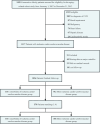Ischemic cardio-cerebrovascular disease and all-cause mortality in Chinese elderly patients: a propensity-score matching study
- PMID: 38879523
- PMCID: PMC11179225
- DOI: 10.1186/s40001-024-01929-x
Ischemic cardio-cerebrovascular disease and all-cause mortality in Chinese elderly patients: a propensity-score matching study
Abstract
Background: Ischemic cardio-cerebrovascular disease is the leading cause of mortality worldwide. However, studies focusing on elderly and very elderly patients are scarce. Hence, our study aimed to characterize and investigate the long-term prognostic implications of ischemic cardio-cerebrovascular diseases in elderly Chinese patients.
Methods: This retrospective cohort study included 1026 patients aged ≥ 65 years who were categorized into the mono ischemic cardio-cerebrovascular disease (MICCD) (either coronary artery disease or ischemic stroke/transient ischemic attack) (n = 912) and the comorbidity of ischemic cardio-cerebrovascular disease (CICCD) (diagnosed with both coronary artery disease and ischemic stroke/transient ischemic attack at admission) (n = 114). The primary outcome was all-cause death. The mortality risk was evaluated using the Cox proportional hazards risk model with multiple adjustments by conventional and propensity-score-based approaches.
Results: Of the 2494 consecutive elderly patients admitted to the hospital, 1026 (median age 83 years [interquartile range]: 76.5-86.4; 94.4% men) met the inclusion criteria. Patients with CICCD consisted mostly of very elderly (79.2% vs. 66.1%, P < 0.001) individuals with a higher burden of comorbidities. Over a median follow-up of 10.4 years, 398 (38.8%) all-cause deaths were identified. Compared with the MICCD group, the CICCD group exhibited a higher adjusted hazard ratio (HR) (95% confidential interval, CI) of 1.71 (1.32-2.39) for long-term mortality after adjusting for potential confounders. The sensitivity analysis results remained robust. After inverse probability of treatment weighting (IPTW) modeling, the CICCD group displayed an even worse mortality risk (IPTW-adjusted HR: 2.07; 95% CI 1.47-2.90). In addition, anemia (adjusted HR: 1.48; 95% CI 1.16-1.89) and malnutrition (adjusted HR: 1.43; 95% CI 1.15-1.78) are also independent risk factors for all-cause mortality among elderly and very elderly patients.
Conclusions: Our results thus suggest that elderly patients with ischemic cardio-cerebrovascular disease and anemia or malnutrition may have higher mortality, which may be predicted upon admission. These findings, however, warrant further investigation.
Keywords: Cohort study; Ischemic cardio-cerebrovascular disease; Mortality risk; Poly-vascular disease.
© 2024. The Author(s).
Conflict of interest statement
The authors declare that they have no competing interests.
Figures




Similar articles
-
[Association of urinary albumin-to-creatinine ratio and cardiovascular health score with cardio-cerebrovascular mortality and all-cause mortality in urban elderly residents in Beijing].Zhonghua Liu Xing Bing Xue Za Zhi. 2025 Mar 10;46(3):385-392. doi: 10.3760/cma.j.cn112338-20240711-00417. Zhonghua Liu Xing Bing Xue Za Zhi. 2025. PMID: 40113388 Chinese.
-
[Association between hypertension subtypes and risk for all-cause mortality and cardio-cerebrovascular mortality in the elderly in communities of Beijing].Zhonghua Liu Xing Bing Xue Za Zhi. 2025 Mar 10;46(3):366-375. doi: 10.3760/cma.j.cn112338-20240713-00423. Zhonghua Liu Xing Bing Xue Za Zhi. 2025. PMID: 40113386 Chinese.
-
Cardiovascular outcomes among elderly patients with heart failure and coronary artery disease and without atrial fibrillation: a retrospective cohort study.BMC Cardiovasc Disord. 2019 Jan 15;19(1):19. doi: 10.1186/s12872-018-0991-1. BMC Cardiovasc Disord. 2019. PMID: 30646855 Free PMC article.
-
Elevated levels of adiponectin associated with major adverse cardiovascular and cerebrovascular events and mortality risk in ischemic stroke.Cardiovasc Diabetol. 2020 Aug 8;19(1):125. doi: 10.1186/s12933-020-01096-3. Cardiovasc Diabetol. 2020. PMID: 32771014 Free PMC article.
-
Cardio-Cerebrovascular Disease is Associated With Severity and Mortality of COVID-19: A Systematic Review and Meta-Analysis.Biol Res Nurs. 2021 Apr;23(2):258-269. doi: 10.1177/1099800420951984. Epub 2020 Aug 27. Biol Res Nurs. 2021. PMID: 32851851 Free PMC article.
Cited by
-
Association between stress hyperglycemia ratio (SHR) and long-term mortality in patients with ischemic stroke: a retrospective cohort study.Cardiovasc Diabetol. 2025 Apr 25;24(1):180. doi: 10.1186/s12933-025-02730-8. Cardiovasc Diabetol. 2025. PMID: 40281588 Free PMC article.
-
Data collaboration for causal inference from limited medical testing and medication data.Sci Rep. 2025 Mar 21;15(1):9827. doi: 10.1038/s41598-025-93509-0. Sci Rep. 2025. PMID: 40118898 Free PMC article.
References
MeSH terms
LinkOut - more resources
Full Text Sources
Miscellaneous

